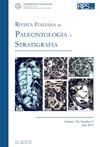摩尔多瓦共和国cioburciu遗址的turrolian河马:系统分类和古饮食
IF 1.9
3区 地球科学
Q2 GEOLOGY
引用次数: 1
摘要
摩尔多瓦共和国的Cioburciu hipparions被包括在turrolian组合中,大约可以追溯到900万到700万年前。本文对它们的分类位置、系统分类学、生物地理学和古饮食习性进行了评价。我们进行了标准的马体测量,并访问Vera Eisenmann网站进行测量和图像,并分析了颅齿和颅后元素。这一组合被确定为中等大小的海马,具有细长的口鼻,发育良好的眶前窝,背侧广泛,靠近眶,缺乏犬窝,有一个突出而深的颊窝。因此,该组合可参考西乌克兰、巴尔干、罗马尼亚、格鲁吉亚共和国、土耳其和伊朗共同的Cremohipparion moldavicum Gromova 1952。我们结合了使用介观磨损方法的大体颊齿磨损形态和使用光学显微镜微磨损技术对咬合牙釉质疤痕进行显微分析。这些互补的古饮食方法表明,这些河马参与了一种混合摄食的饮食行为,并且Cioburciu样本的C. moldavicum可能在季节性和/或区域性之间交替觅食和放牧。基于平均划痕和坑数的分层聚类分析将该分类群定位于现存的混合摄食有蹄类动物中。通过微磨损技术评估的大凹痕和凿痕表明,与典型的混合喂食者或食草者相比,它们偶尔会食用相对粗糙的食物,或者在死前食用含沙砾的食物,而中磨损表明,这不是一种终生习惯。本文章由计算机程序翻译,如有差异,请以英文原文为准。
THE TUROLIAN HIPPARIONS FROM CIOBURCIU SITE (REPUBLIC OF MOLDOVA): SYSTEMATICS AND PALEODIET
The Cioburciu hipparions, Republic of Moldova, are included in a Turolian assemblage, approximately dated between 9 and 7 million years. We assess herein their taxonomic position, systematics, biogeography and paleodietary habits. We have undertaken standard equid measurements as well as accessing the Vera Eisenmann website for measurements and images and analysed craniodental and postcranial elements. This assemblage has been determined to be of a medium-sized hipparion with an elongated muzzle, well developed preorbital fossa that is dorsoventrally extensive and placed close to the orbit, lacking a caninus fossa and having a prominent and deep buccinator fossa. As such, this assemblage is referable to Cremohipparion moldavicum Gromova 1952 common to the Western Ukraine, Balkans, Romania, Republic of Georgia, Turkey and Iran. We have employed a combination of gross cheek tooth wear morphology utilizing the mesowear method and a microscopic analysis of occlusal enamel scars utilizing the light microscope microwear technique. These complementary paleodietary methods indicate that these hipparions engaged in a mixed feeding dietary behavior and that the Cioburciu sample of C. moldavicum likely alternated its diet between browsing and grazing seasonally and/or regionally. A hierarchical cluster analysis based on average scratch and pit numbers positions this taxon among extant mixed feeding ungulates. Large pitting and gouging assessed through the microwear technique indicates occasional consumption of relatively coarser foods than typical mixed feeders or grazers or grit-laden food just prior to death while mesowear indicates that this was not a lifetime habit.
求助全文
通过发布文献求助,成功后即可免费获取论文全文。
去求助
来源期刊
CiteScore
3.60
自引率
4.30%
发文量
28
审稿时长
>12 weeks
期刊介绍:
The Rivista Italiana di Paleontologia e Stratigrafia was founded in 1895. It publishes original papers dealing with all fields of paleontology and of stratigraphy, from Italy and the Mediterranean to the Tethys, as well across the globe from China to North America.

 求助内容:
求助内容: 应助结果提醒方式:
应助结果提醒方式:


